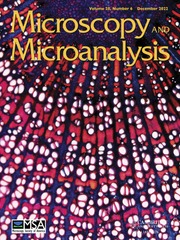Article contents
Semiconductor Failure Analysis Using EBIC and XFIB
Published online by Cambridge University Press: 02 July 2020
Abstract
Electron beam induced current (EBIC) is the common term used in the semiconductor industry for the failure analysis and yield enhancement of semiconductor devices using SEM to electrically pinpoint leakage sites. EBIC is a useful technique for locating defects in diodes, transistors, and capacitors where the scanning electron microscope beam is used to generate a signal and the sample is the detector. Often during yield enhancement efforts the failure analyst is asked to determine the mechanism for which a PC structure (which may contain as many as a few hundred thousand structures in one device) is failing tests. Blind cross sections rarely give evidence of the failure mechanism. EBIC can be used to pinpoint the bad site which is then precision cross-sectioned using the focused ion beam (FIB).
When an electron beam impinges on a semiconductor such as silicon, electron-hole pairs are created when the incident beam transfers enough energy to promote an electron from the valance band to the conduction band.
- Type
- Microscopy in the Real World: Semiconductors and Materials
- Information
- Copyright
- Copyright © Microscopy Society of America 2001
- 2
- Cited by


